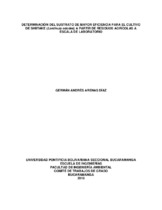Determinación del sustrato de mayor eficiencia para el cultivo de Shiitake (lentinula edodes) a partir de residuos agrícolas a escala de laboratorio
Fecha
2018Director/Asesor
Gamarra Hernández, Yolanda
Tipo de contenido
Trabajo de grado
Citación
Metadatos
Mostrar el registro completo del ítemDocumentos PDF
Resumen
La investigación se enfoca en el aprovechamiento de la biomasa vegetal de residuos agrícolas con altos contenidos de lignocelulosa como lo son la borra residual generada en la preparación del café y la tusa de maíz, por medio del cultivo de la seta comestible de alto contenido proteico, L. edodes (Shiitake). Estos desechos se emplearon en la preparación de cinco tratamientos (Tratamiento A (TA), Tratamiento B (TB), Tratamiento C (TC), Tratamiento D (TD) y Tratamiento E (TE)) constituidos por combinaciones de los residuos mencionados en diferentes proporciones que varían en su porcentaje en peso y a los cuales se les fueron asignados cinco réplicas por tratamiento. La preparación de las unidades experimentales se hizo a escala de laboratorio y su desarrollo se efectuó durante un periodo de ocho semanas en la cámara de emulación del clima, en donde se recreaban las condiciones ambientales requeridas por el hongo. Con el fin de determinar el sustrato que presenta la mayor eficiencia en cuanto al crecimiento del shiitake, se reportaron los valores correspondientes a factores como el número de cuerpos fructíferos, las medidas de la longitud de pie y ancho del sombrero de los cuerpos fructíferos y la tasa de biodegradación. Los resultados experimentales indicaron que TE es el tratamiento de mayor eficiencia al presentar la mayor tasa de biodegradación con un 44.43%, junto a la tendencia de generar el mayor número de cuerpos fructíferos en promedio. En cuanto a las medidas de los cuerpos fructíferos TA tuvo en promedio el mayor ancho del sombrero con 2.1cm y TE presentó la mayor longitud de pie con 1.31 cm en promedio. The research focuses on the use of vegetable biomass from agricultural residues with high levels of lignocellulose, such as waste generated in the preparation of coffee and the cob, through the cultivation of the high protein edible mushroom, L. edodes (Shiitake).Said wastes were used in the preparation of five treatments (Treatment A (TA), Treatment B (TB), Treatment C (TC), Treatment D (TD) y Treatment E (TE)) constituted by combinations of the mentioned residues in different proportions that vary in their weight percentage and to which five replications were assigned per treatment. The preparation of the experimental units was done on a laboratory scale and its development was carried out during a period of eight weeks in the climate emulation chamber, where the environmental conditions required by the fungus were recreated in order to determine the substrate that shows the highest efficiency in the growth of the shiitake, the values corresponding to factors such as the number of fruit bodies, the measurements of the foot length and hat width of the fruiting bodies and the rate of biodegradation. The experimental results indicated that TE is the most efficient treatment with the highest rate of biodegradation with 44.43%, together with the tendency to generate the highest number of fruiting bodies with an average of 5 for each experimental unit. Regarding the measures of the fruiting bodies TA had on average the largest width of the hat with 2.1cm and TE had the longest foot length with 1.31 cm on average.
Palabra/s clave
Residuos agrícolas
Hongos
Biodegradación
Maíz
Colecciones
- Trabajos de grado [6698]
El ítem tiene asociados los siguientes ficheros de licencia:


